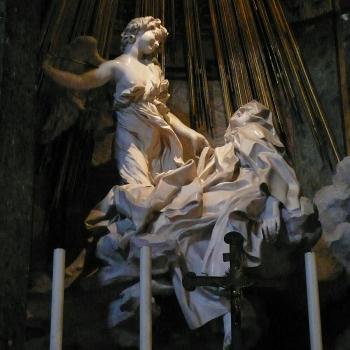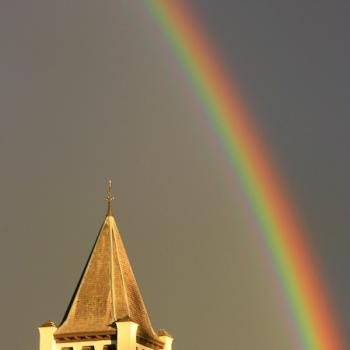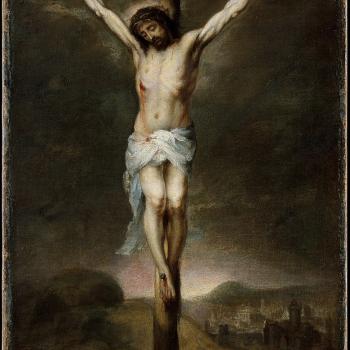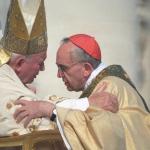Last week I did a speaking engagement in New York, on the topic, “Christianity Is the Most Materialistic of Religions.” I did not choose this topic (BOOK ME, I WILL ROLL WITH WHATEVER WEIRD-ASS THING) and one theme that emerged from my unusually rambling performance was that Christianity cherishes and celebrates the body, but not in the way you might like. You can watch the videos here (in three parts, so check the order)–seriously, I always ramble and get tangled but this was an astonishing exhibition of mental spaghetti nests–but let me add a few notes.
Before I converted I had a fairly standard stereotypical view of Catholicism: life-hating, woman-hating, body-hating, sex-hating, etc etc. This was weird and unreflective (I talk about my pre-conversion reliquary obsession in the Part I video) but that’s where I was coming from. And so the people who first shared the Gospel with me in terms I could understand were at pains to say no, Catholicism exalts the body, we see God’s fingerprints in the beauty of the physical world, the light by which the poet sees truth within material objects is the light of the Creator, etc. There’s so much kissing in Scripture!
True enough, and important for me, then and now. But also only a small part of the story of Catholicism’s relationship to the body–and perhaps a part that has become swollen in contemporary apologetics. The pop-poetic version is, “Wherever the Catholic sun doth shine/There’s always laughter and good red wine.” The pop-degenerate version often goes something like, “How NFP Can Spice Up Your Marriage!”
(The anti-Protestant version is that great exchange from Blackadder, when Blackadder’s Puritan relatives are shocked by the decadent luxury of chairs: “At home, Nathaniel sits on a spike!” “And where do you sit?” “On Nathaniel!”)
The Body most exalted in our faith still bears the marks of its sacred wounds. We cherish and revere Christ’s Body in His suffering. When Catholics ask, What is the value of the body?, I think the best answer is something like Thomas a Kempis’s reworking, in his Reflections on the Passion of Christ, of the Song of Songs as a hymn to the Bridegroom in His crucifixion.
The Canticle of the Creatures, that hymn to the world God made for us, includes thanksgiving for Sister Death.
Forgetting this will warp our faith. If the body is honored only in its pleasures, how can our faith speak to suffering people? “Wherever the Catholic sun doth shine”–okay, but what about when the hurricane destroys your city? Francis Spufford made this fierce little point that the British atheist slogan, “There’s probably no God. Now stop worrying and enjoy your life,” is utterly callous to unrelieved suffering. Cheer up, there will be no forgiveness, no justice, no better life for you when your suffering here is past! “What the atheist bus says is: there’s no help coming.”
A sunshiney view of the body tempts us to overvalue the pleasures our culture celebrates. We revel in food but neglect the discipline of fasting. We view sex as the primary and perhaps even the only true way to love someone with your body, which is very weird given that Jesus, Who is Love incarnate, lived a virgin. Jesus loves with His body: in service, as when He washed the disciples’ feet; in healing with a touch (or with very odd stuff like mud mixed with spit, God is bizarre); in His tender friendships, the intimacy of John the beloved disciple resting his head on Jesus’ breast; in nourishing us with His Body and Blood; and, perhaps above all, in His suffering and death.
Our bodies are gifts. But for most people they are also crosses, sources of intense physical and spiritual suffering, at least some of the time.
Our faith responds to this reality in a lot of different ways. One is by offering beauty as solace to those who suffer. There’s a point in those videos where I say I’ve forgotten something, and I did eventually remember it: I wanted to talk about the “Hail, Holy Queen.” This prayer is super intense about the suffering of this life: “in this our exile,” “mourning and weeping in this valley of tears.” And Mary comes to us here with her sweetness: an aesthetic term. So too the churches should be beautiful in part because they are places of refuge, places where you can find sweetness without paying for it, where your soul can rest in beauty even when you’re hungry and frightened and don’t know what to do. The beauty of our churches is part of their charity.
(Side note: You can agree with that without making it into a polemic for one particular aesthetic, you know. One of the most lovely hymns I’ve heard was “Amazing Grace” as played on the Casio keyboard: childlike, poignant, stripped down and made slightly alien, an inbreaking from a weirder world.)
Catholics also honor the body in its suffering by remembering that this world is not our home; this life is fleeting. Here’s my favorite expression of our ephemeral life that I’ve seen recently. It also features pretty women! The best theology.
And by asceticism. By entering voluntarily into suffering we not only do penance for sin, but remind ourselves that to suffer is to draw closer to Christ Crucified. (I’ll take any excuse to link you to this defense of flagellation btw.)
And by absurdity. The cackling, ridiculous approach. This is one of my favorites: the dancing skeletons, in a totentanz or a Dia de los Muertos band. Our weakness reduced to camp; and loved, the way camp always loves its ridiculous subjects.
And by service, friendship, giving our bodies to others. If you don’t sacrifice with your body how can you know its true worth?
And by worship. Humbling the body to kneel, to prostrate oneself, to be loved in one’s abjection.
And, sometimes, by silent presence. There are times when illness, heartbreak, grieving, the ache of unfulfilled longing doesn’t seem to find any comfort in the practices of the Church: when beauty, service, self-denial, worship don’t help in any discernible way. In those moments maybe all we can do is try to be with one another (this is much harder than it sounds), and pray the prayers we learned a long time ago, and try to remember that we’re in those prayers too. When you’re in that place where nothing “helps,” that doesn’t mean that you’re doing anything wrong. It means that you’re experiencing the world as a valley of tears. The prayers given us by the Church have a place for us, in this our exile.















